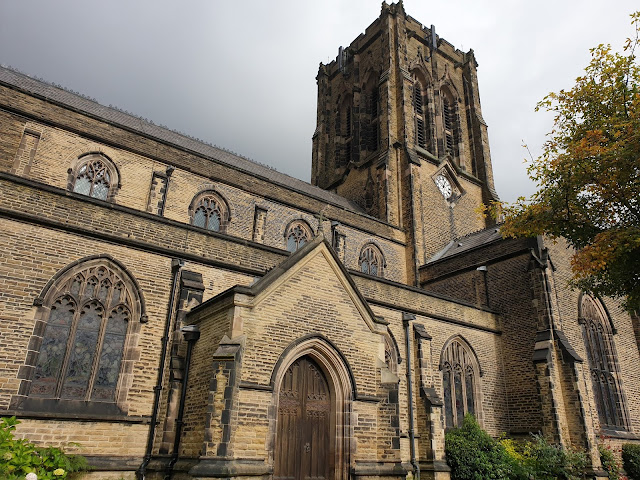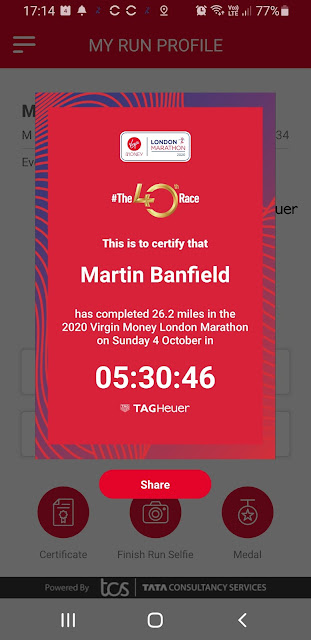
Graeme and I set off along the Bridgewater Canal towpath from Timperley around 10 am and picked up Paul at Seamons Moss Bridge, beyond Altrincham.
Continuing to the exit to the Swan With Two Nicks, we enjoyed the easy stroll beside the canal.
Beyond the pub, the River Bollin was frothing over the weir, and the footpath to Dunham Massey involved a shuffle along a wooden fence unless you had wellies. We shuffled.
The Dunham Barn café provided welcome sustenance under cover, thus avoiding a shower, before we continued to cross the golf course and make our way home via Altrincham (Paul peeled off by St Margaret's Church as there was little point in his going home to Hale via the town centre.)
Then on a showery afternoon I cycled to Didsbury and back, still somehow avoiding the increasingly intense rain showers.
Today's picture (above) was taken on the path that leads to the pedestrian exit from Dunham Massey. Further illustrations and comments may follow when I have more time...
Later:
The Bridgewater Canal was constructed over a considerable period, starting around 1761, a very long time ago. I doubt whether the crane shown above, probably for lifting stop planks to enable a section of the canal to be drained for maintenance purposes, near the small marina at Altrincham, dates from quite that long ago.
There's a lot about the history of the canal
here, and below is an extract that covers the section between Stretford and Runcorn beside which we were walking.
"At the end of 1761, the Canal was completed through to Stretford and to Castlefield Wharf, Manchester by 1765.
Whilst this work was being carried out, the Duke and his team were busy on the next phase of extending the Canal to the Mersey tideway at Runcorn to forge a link with the Port of Liverpool. Despite opposition, the Duke’s third Act to make this possible was passed in March 1762.
The need for an embankment and aqueduct over the Mersey at Sale Moor and similarly across the River Bollin, coupled with disputes with landowners, delayed work under this Act. At the Runcorn end the principal landowner, Sir Richard Brooke of Norton Priory, held up completion for many years.
Before the Canal reached Preston Brook, about five miles from Runcorn, the Trent and Mersey Canal was under construction. The Act of 1766 for the Trent at Mersey Canal, which the Duke was involved in, included a provision empowering him to change the route of his Canal from the junction at Preston Brook to a point lower down the Mersey at Runcorn Gap, opposite Widnes, a more convenient point for barges to proceed on the tideway after descending by a flight of 10 locks.
Eventually in spite of all the trials and tribulations, the Canal between Liverpool and Manchester was completed in the spring of 1776, four years after James Brindley died."
We met Paul at Seamons Moss Bridge, by the defunct Bay Malton hostelry. It took a close scrutiny of the bridge by Graeme for him to work out its recent history. The new brickwork gives the clue - recent repairs after a lorry that was too wide attempted to destroy the bridge.
A little further on, this swan seemed intent on a drifting snooze.
After leaving the towpath, we passed under the canal to reach the Swan with Two Nicks. Paul explained the background to that name - here's an extract from the pub's website that reiterates what Paul told us.
"From the 12th century, the monarch has retained the right to ownership of all unmarked mute swans in open water, but in practice only exercised ownership on certain stretches of the Thames. At that time swans were a common food source for royalty.
Swan upping became the means of establishing a swan census. Under a 15th century Royal Charter, the Vintners’ Company and the Dyers’ Company, two Livery Companies of the City of London, are entitled to share in the Sovereign’s ownership and it is they who conduct the census through a process of ringing the swans’ feet.
The annual swan upping takes place during the third week of July. During the ceremony, the Queen’s, the Vintners’, and the Dyers’ Swan Uppers row up the river in skiffs. Swans caught by the Queen’s Swan Uppers under the direction of the Swan Marker are ringed. Those caught by the Dyers and Vintners are identified as theirs by means of a further ring on the other leg. Today, only swans with cygnets are caught and ringed. This gives a yearly snapshot as to how well Thames swans are breeding.
Originally, the two companies made their own marks on the birds’ beaks: one nick for a dyers’ bird and two for a vintners’; today the two Companies use their own rings. This practice provided the name of our pub “The Swan with Two Nicks”. This was a 16th century pun, the word “nick” also meaning “neck”. Humour wasn’t quite what it is today… So we also find a lot of pubs called The Swan with Two Necks."
Beyond the pub, a footbridge across the River Bollin offers a good view of a weir, over which the water was frothing after quite a bit of rain recently.
Crossing the causeway to Dunham Massey park, wellies would have been welcome, and either side of the footpath the fields were inundated by a shallow flood.
After walking through Dunham Massey's grounds, coffee and cake at Dunham Barn were most welcome. After that it's a walk through fields and across a golf course to reach the main A56 road, where Paul left us at St Margaret's, where Sue is a bellringer - mainly hand bells outside in these times of turmoil.
Here's the route that Graeme and I took - 13.5 km in around 3 hours plus café stop. Paul's route from Hale was a bit shorter.
Next week - a walk from Tegg's Nose, near Macclesfield. Details will be on
topwalks.com next week. Let me know if you plan to join us.
Later:
Paul kindly sent me the following information, giving more about the section of the canal we walked beside, and about the events in 1971 that put the survival of the canal at risk. I was in Manchester then; how is it that I don't recall that flood damage? (Click on the images for readable versions.)




















